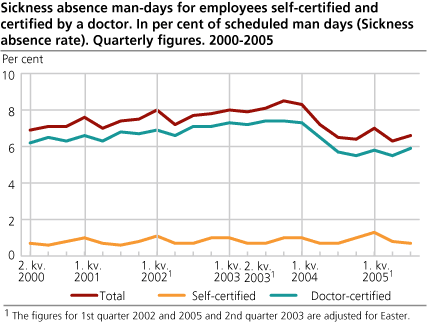Content
Published:
This is an archived release.
Stability in sickness absence
The sickness absence rate increased from 6.5 per cent in the third quarter of 2004 to 6.6 per cent in the third quarter of 2005. Absence certified by a doctor increased from 5.7 to 5.9 per cent, and the self-certified absence was 0.7 in both quarters.
The increase of the sickness absence was 2.4 per cent from the third quarter of 2004 to the third quarter of 2005. The growth for men was 2.0 per cent and2.8 per cent for women. The sickness absence was 11.3 per cent lower compared with the third quarter of 2001 - the year when the agreement on an inclusive labour market was implemented.
Large variation between industries
Among the larger industries, the growth of the sickness absence was largest in oil and gas extraction with 12.2 per cent. However, the sickness absence level in this industry still remains well below the average sickness absence. The growth was also relatively strong in public administration and defence with 4.2 per cent.
Although the sickness absence increased from the third quarter of 2004 to the third quarter of 2005, the sickness absence decreased in some industries. The decrease was largest in hotels and restaurants with 5.9 per cent.
Largest increase in the Middle and Northern Norway
In all, the increase was larger in the two Trøndelag-counties and in Northern Norway than in the rest of Norway. The increase was largest in Nord-Trøndelag with 12.1 per cent and Troms with 9.1 per cent. Some of the development in the five most northern counties can be addressed to the extra large increase of sickness absence in public administration and defence, as well as in health and social work in several of these counties.
The sickness absence decreased from the third quarter of 2004 to the third quarter of 2005 in Østfold, Akershus, Buskerud, Vestfold and Aust-Agder.
The sickness absence level still was lowest in Rogaland with 5.1 per cent and highest in Finnmark with 8.3 per cent.
Decrease in the proportion of long-lasting absences
Sickness absence lasting the entire quarter, added up to 32.2 per cent of the sickness absence in the third quarter of 2005. This was a small decrease from 32.5 per cent in the third quarter of 2004. Sickness absence not lasting the entire quarter, but still more than 31 days, dropped from 30.5 per cent to 29.4 per cent.
Strongest increase in Local government
In local government, the sickness absence increased by 5.4 per cent from the third quarter of 2004 to the third quarter of 2005. At the same time, the sickness absence rose by 3.2 per cent in the central government (including the state hospitals) and 1.4 per cent in private sector and public enterprises. Within local government, public administration contributed mostly to the growth, whereas the state hospitals contributed mostly to the growth in central government.
The following results are based on data on sickness absence certified by a doctor, as the survey on self-certified absence does not contain data on sickness absence by age.
Rise in age groups between 30 and 60 years old
The sickness absence increased in all age groups between 30 and 60 years old, both for women and men. For women above 60 years old, the sickness absence decreased by more that five per cent in all age groups.
The sickness absence rate measures the proportion of scheduled man-days lost due to own sickness. The statistics do not cover self-employed persons.
Tables:
- Table 1 Sickness absence man-days for employees self-certified and certified by a doctor. In per cent of scheduled man-days (sickness absence rate). Quarterly figures. 2000-2005
- Table 2 Sickness absence man-days for employees self-certified and certified by a doctor, by sex. In per cent of scheduled man-days (sickness absence rate). Quarterly figures. 2000-2005
- Table 3 Sickness absence man-days for employees self-certified and certified by a doctor, by industry and type of sickness absence. In per cent of scheduled man days (sickness absence rate). Quarterly figures. 2000-2005
Contact
-
Arbeidsmarked og lønn
E-mail: arbeidsmarked@ssb.no
-
Unn H. Høydahl
E-mail: unnh.hoydahl@ssb.no
tel.: (+47) 40 90 23 77

